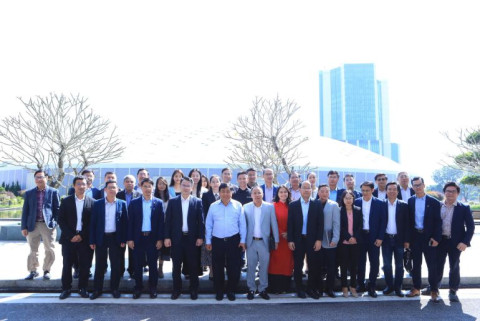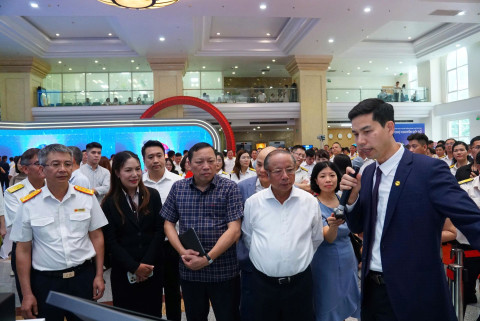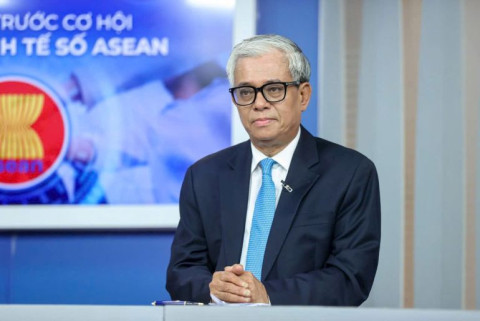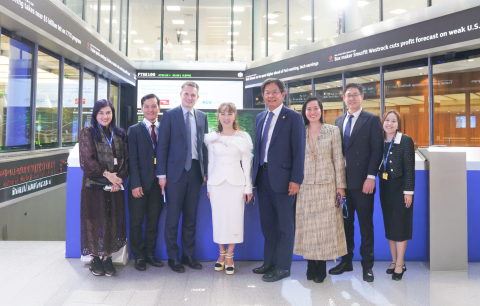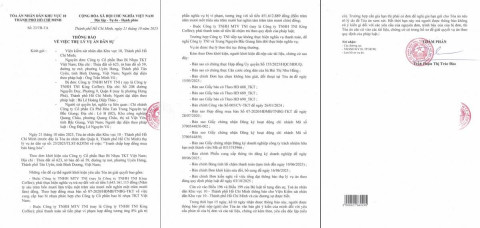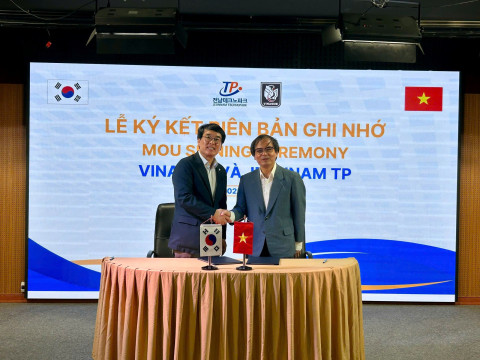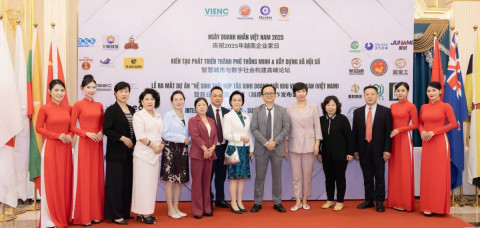Binh Duong Planning to create an infrastructure development strategy
- 125
- Business
- 02:10 20/03/2023
DNHN - A recent conference was held at the Convention and Exhibition Center of Binh Duong province planning for the province of Binh Duong's midterm future.
Attending were Mr. Nguyen Van Loi - Member of the Party Central Committee, Secretary of the Provincial Party Committee, Head of the Provincial National Assembly Delegation, Head of the Provincial Steering Committee for Planning; Mr. Vo Van Minh - Deputy Secretary of the Provincial Party Committee, Chairman of the Provincial People's Committee; Mr. Nguyen Van Hung - Chairman of the Board of Directors of Becamex IDC Corporation, member of the Steering Committee for Provincial Planning; together with the members of the Steering Committee, the Supporting Group of the Steering Committee for the formulation of provincial planning; leaders of departments, agencies, districts, towns, and cities; provincial planning consulting unit.
System development for space and infrastructure
The consulting unit reported the following at the workshop: Orienting the strategic framework to integrate planning in Binh Duong province; development orientation of key industries and fields; and orientation of spatial development planning and infrastructure system.
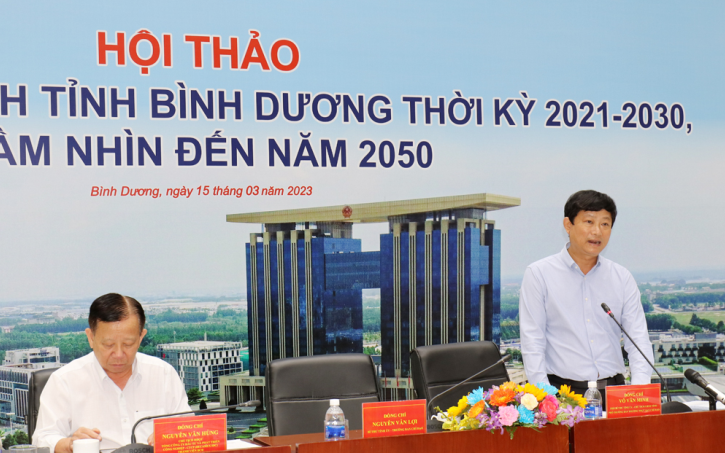
This integrated strategy is based on Binh Duong's advantageous location and regional connectivity so that, by 2030, it will be the first high-income province in Vietnam, the hub of international trade, and the center of Southeast Asia. The report at the beginning of the period highlighted the province of Binh Duong's unique position as a major transit hub between the Central Highlands, the Southeast, the Southwest, and Ho Chi Minh City, an important travel industry link. Southeast commercial corridor. Binh Duong serves as the northern flank of Ho Chi Minh City, as well as the flank with the greatest natural resources due to its proximity to the Central Highlands, Southern Laos, and Eastern Cambodia.
The northern sub-region, including Tay Ninh and Binh Phuoc provinces, as well as the northern region of Dong Nai and Binh Duong provinces, is a border-gate economic development zone, expanding the industrial development space of the region; The central sub-region, including Ho Chi Minh City, the southern region of Binh Duong province, and the southwestern region of Dong Nai province, is the development center of the entire region, outstanding with its strengths in agriculture, industry, a hub for high-quality services, education - training, healthcare, and international commerce.
Through more than 25 years of development, Binh Duong has amassed a substantial infrastructure base, which is a valuable result of the province's planning process and implementation. However, according to Associate Professor Dr. Hoang Vinh Hung - Deputy Director of VIUP, Binh Duong faces several bottlenecks and obstacles that must be resolved by resources and generate overall motivation to bring Binh Duong forward. Duong continues to grow in the modern era. In particular, regional connections are congested, and the transport infrastructure connecting the southern portion of the province is overburdened. The economic growth model faces numerous obstacles, including the middle-income trap, a low proportion of service economy structure, and a lack of high-quality human resources; production is labor- and land-intensive. Alongside this are the challenges of spatial model and infrastructure development without a long-term vision; values of cultural and ecological resources are being forgotten and services are limited; a social environment with many potential risks; competition in the region and the country is intensifying, international fluctuations are unpredictable, etc.
The master plan aims for Binh Duong to develop according to the model of a centrally administered city by 2030, making it an important growth pole of the Southern Key Economic Zone and the entire nation.
Binh Duong was a pioneer in the transformation of the development model towards modern industries and high-quality services centered on a comprehensive innovation ecosystem. The average economic growth rate between 2021 and 2030 will be approximately 10% per year; the GRDP per capita will be approximately 15,700 USD (412 million VND); and the proportion of the digital economy will reach 30% of the GRDP. The province's GDP per capita is approximately $31,300, making it a province with a high middle-income level, and the proportion of the processing and manufacturing industry has reached 50 percent of the GDP.
The Workshop's discussions revealed that achieving the set objectives and escaping the "middle-income trap" is not only an economic challenge but also a test of local governance capacity. According to MSc.Architect Nguyen Xuan Anh - VIUP Institute, for Binh Duong to become a regional hub and focal point based on open development, the province must continue to combine with national programs and collaborate with localities. To encourage the completion of road, rail, and river connections with the center of Ho Chi Minh City in the surrounding areas. In addition, the province continues to develop according to an innovation model based on expanding the development space of existing industrial parks and urban centers, applying science and technology to production, management, and social services, thereby contributing to the province's development. Create a new type of ecosystem for the province's socioeconomic development. The province's six pillars of development promotion for the upcoming period consist of the following: inheritance development, innovation-based development, specialized coordinated development, sustainability-based development, multilateral open development, and all-encompassing common development.

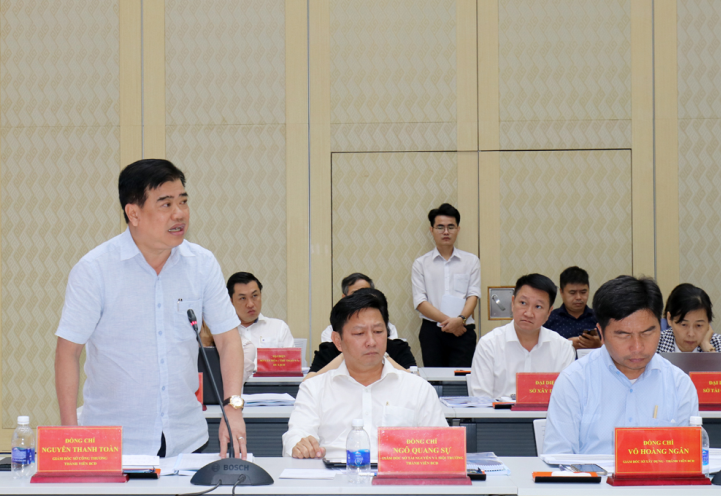
In regional connections, the Planning Law of 2017 imposes stricter requirements on the integration of goals and interdisciplinary approaches in provincial planning on the same development territory. Integration necessitates coordination between sectors, levels, and stakeholders to solve immediate and long-term issues, thereby ensuring that the provincial planning has a long-term perspective.
Binh Duong planning period 2021-2030
Binh Duong identifies the significance and role of provincial planning as a guideline for the new development period and beyond, to develop a breakthrough into a high-income province based on three philosophies: establishing an effective business and investment environment; fostering a harmonious, humane, and sustainable society; and establishing a dynamic and constructive local government. Provincial planning for the period 2021-2030, with a vision to 2050, will be a crucial tool for orienting, operating and managing the province's continued rapid and sustainable development.
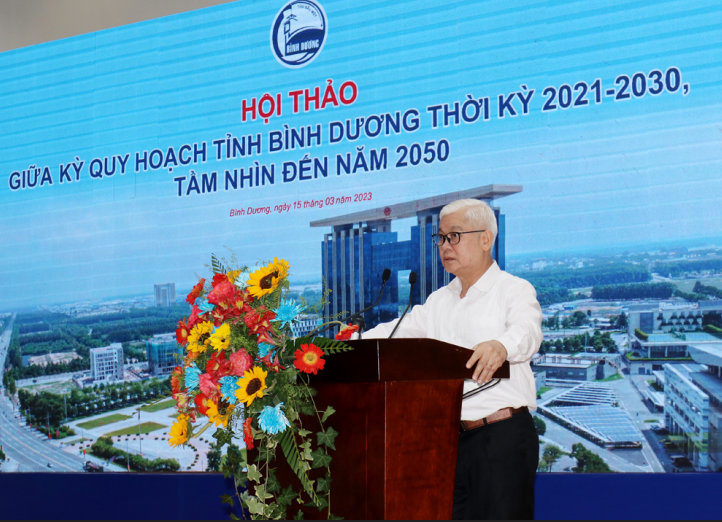
Secretary of the Provincial Party Committee Nguyen Van Loi stated during the workshop that this draft is a step closer to improving the content and depth of the planning's requirements, especially after absorbing quite positive feedback during the first session of the Seminar. The content of each section of the draft Master Plan largely adheres to the provincial development requirements and Resolution No. 24 of the Politburo.
The Secretary emphasized several essential contents for experts, scientists, and departments to continue researching and refining the planning scheme for submission to the final workshop, in which it is essential to adhere to Resolution No. Binh Duong's potential conditions and competitive advantages to determine the most optimal, appropriate, and feasible development scenario.
Specifically, regarding the spatial orientation of development in Binh Duong, spatial research develops into regions: The southern region, which includes Thuan An, Di An, and Tan Uyen, is Binh Duong's gateway to Ho Chi Minh City. Ho Chi Minh City, Dong Nai, and the seaports are regional transportation hubs. A modern city with housing infrastructure, high-quality services, medical and educational systems of international standard, and public transportation linking Ho Chi Minh City, Dong Nai, and the city center. New streets of Binh Duong, Thu Dau Mot, Ben Cat, and Bau Bang are "magnets" for attracting people to live, as well as an instrument for attracting high-quality human resources, material resources, and economic restructuring. The economy in the province's central and northern regions.
The central area of Binh Duong (Thu Dau Mot, Ben Cat, and Tan Uyen) with the "center of Binh Duong New City" as its nucleus must continue to be planned to become an innovation zone, the urban core. smart Binh Duong.
The northern localities (Ben Cat, Bau Bang, Phu Giao, Dau Tieng, and Bac Tan Uyen) still have a sizable amount of land available; therefore, they must coordinate to prepare industrial real estate and form a belt. The center connecting the Southeast region to the river port created by the ring roads is the industrial district. This region must become a new development pole to form the Culture - Fitness - Sports - Health - Education Complex to support the development poles of the province and the entire Southeast region. set.
Regarding specific areas, the province's 2022-2030 goal must emphasize the development of 10,000 hectares of the industry to form an industrial belt, as well as urban areas, services, and logistics along the Ring 4 corridor, among other areas. In the region's northern districts and towns, expressway routes continue to develop industry and serve as a place to relocate or restructure businesses (about 2,888 businesses must relocate to the North). Approximately 2,000 hectares remain for urban development and service provision in Thuan An and Di An, which will become regional urban centers. Under the province's relocation project, 30% to 40% of the South's manufacturing enterprises must be relocated to industrial zones and clusters in the North by 2025. Since then, there has been the formation of specialized industrial parks, science, and technology industrial parks, supporting industrial parks, green industries, circular industries, and industry 4.0. Aiming for at least 30 percent of businesses to adopt automated production models by 2030.
In addition, space must be allocated to shape the development of high-quality service industries in the direction of becoming regionally prominent, high-quality financial, commercial, educational, and healthcare centers. world, additional services
Regarding urban development, it is necessary to prioritize planning, investment, embellishment, and improvement of urban quality to create a smart, civilized, and modern city that is a desirable place to live, as opposed to "slums" in the urban core. By 2025, it will be necessary to eliminate unconnected alleys, dirt alleys, and red gravel roads, as well as residents who have not met infrastructure requirements and housing development targets (urban and rural housing area) villages, worker's houses, and social housing) based on population projections for each period.
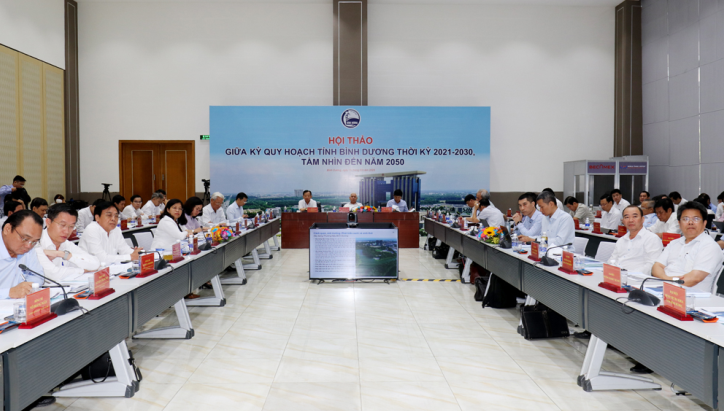
Planning must address the issue posed by the transformation of development models toward the application of science and technology and the transformation of production models to attract a new generation of industry, green industry, and sustainable industry. industry is not labor-, land-, or energy-intensive. Additionally, businesses must transform 4.0 and improve their technology chains. The State constructs a digital government, a digital society, and a digital economy, and reforms administrative procedures in a comprehensive manner. To attract high-quality human resources, it is necessary to create a new ecosystem and plan a system of education and training institutions for development. Identify specific strategies for maximizing the mobilization of resources from all economic sectors to carry out the tasks outlined in the plan, including investments in the completion of socioeconomic infrastructure and key urban areas. This is the infrastructure connecting the region's transportation systems.
The Secretary requested that, by the end of April 2023, the final provincial planning project be completed and public input gathered to finalize the plan. In addition to identifying resources for the effective execution of objectives and tasks, consulting units and sectors must study and propose specific recommendations in terms of institutions and policies to the Central Government to generate resources and motivation for Binh Duong to develop the approved master plan.
Hoang Thu
Related news
- Connecting Leaders, Shaping the Future: Strategic Leadership Planning Meeting – CorporateConnections Hanoi A
- Sunlight - Unilever Vietnam Recognized for Outstanding Contributions to the National Initiative Supporting Women Entrepreneurs
- Deputy Prime Minister Nguyễn Chí Dũng: “The country’s major challenges weigh heavily on my mind — and we must resolve them together.
- Unitsky String Technologies signs cooperation agreements with three Vietnamese partners, opening a new direction for smart mobility and sustainable development
- When artists do business – livelihood is no poetry!
- Before the D‑day to abolish flat‑rate tax: Fear of technology and costs leave small traders struggling to adapt
- Vietnamese enterprises at a crossroads: the impact of a potential US–China deal
- "Digital technicians" must not be forgotten if Vietnam aims to meet its strategic goals
- HDBank: Impressive profit growth, leading in profitability and advancing international integration
- TNI King Coffee sued for over VND 5 Billion in unpaid debts
- VINASME and Jeonnam Technopark Sign MOU on technology cooperation, human resource training, and trade promotion
- Vietnamese entrepreneurs strengthen ASEAN connectivity in the digital iIntegration era
- Prime Minister: Vietnam aims to become a regional logistics hub
- Vietnam upgraded to Secondary Emerging Market by FTSE Russell
- Hanoi’s economy grows 7.92% in first nine months of 2025, FDI surges nearly threefold
- Vietnam’s strong gdp growth fails to ease labor market distress
- US tariffs on Brazil propel Vietnam’s pangasius into global spotlight
- VietLeap AI Accelerator launches: A strategic springboard for Vietnam’s AI startups
- CICON expands strategic alliances: A new step forward in Vietnam–Korea business connectivity
- What must Vietnamese enterprises do to maintain their position in the global supply chain?
Đọc thêm Business
Connecting Leaders, Shaping the Future: Strategic Leadership Planning Meeting – CorporateConnections Hanoi A
"Your network is your most powerful flowing asset. It generates value, multiplies opportunities, and accelerates your influence across borders."
Innovative ESG enterprise: Trạm Xe Việt startup proposes solutions to build a green mobility ecosystem
As Vietnam commits to achieving Net Zero by 2050 and tightens emissions standards, the transportation sector faces unprecedented pressure to transform.
Deputy Prime Minister Nguyễn Chí Dũng: “The country’s major challenges weigh heavily on my mind — and we must resolve them together.
On the morning of November 26, 2025, Deputy Prime Minister Nguyễn Chí Dũng chaired a high-level working session at the National Innovation Center (NIC) in Hòa Lạc.
Unitsky String Technologies signs cooperation agreements with three Vietnamese partners, opening a new direction for smart mobility and sustainable development
The signing ceremony took place in Minsk, Belarus, on November 28, 2025.
Before the D‑day to abolish flat‑rate tax: Fear of technology and costs leave small traders struggling to adapt
From 1 January 2026 the flat‑rate tax regime will be abolished. Small business households will be required to declare tax based on actual revenue. MISA supports the transition with technology to help micro‑merchants adapt smoothly and transparently.
Vietnamese enterprises at a crossroads: the impact of a potential US–China deal
As the world closely monitors every shift in US-China relations, emerging signals of a strategic agreement between the two global powers are raising hopes for global economic stability.
HDBank: Impressive profit growth, leading in profitability and advancing international integration
Ho Chi Minh City Development Joint Stock Commercial Bank (HDBank, stock code HDB) announced its consolidated profit before tax for the first 9 months of 2025 reached VND 14,803 billion, marking a 17% increase year-on-year (YoY).
TNI King Coffee sued for over VND 5 Billion in unpaid debts
On October 21, 2025, the People’s Court of District 10 in Ho Chi Minh City officially accepted a civil lawsuit concerning a commercial contract dispute between TKT Vietnam Plastic Packaging Joint Stock Company and TNI King Coffee Co., Ltd.
VINASME and Jeonnam Technopark Sign MOU on technology cooperation, human resource training, and trade promotion
On October 15, 2025, in Hanoi, VINASME and Jeonnam Technopark (Korea) signed an MOU to promote trade, advance technology transfer, and develop human resources between enterprises of both nations.
Vietnamese entrepreneurs strengthen ASEAN connectivity in the digital iIntegration era
On the occasion of Vietnam Entrepreneurs’ Day (October 13), an international event themed “Integration – Innovation – Sustainable Development” was solemnly held in Ho Chi Minh City.




